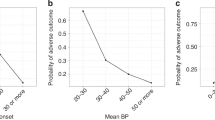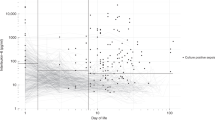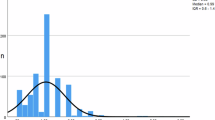Abstract
Mannose binding lectin (MBL) is a soluble pattern recognition receptor of innate immunity that binds a wide range of pathogens and exerts opsonic effects. We investigated the association between serum MBL levels and development of sepsis in infants admitted to neonatal intensive care units (NICUs). Serum MBL levels on admission were measured by enzyme-linked immunosorbent assay (ELISA) in 206 neonates consecutively admitted to an NICU of whom 138 did not develop hospital-acquired sepsis and 68 did. Of these 68, 40 had confirmed sepsis with positive blood cultures, 19 clinically suspected sepsis, with negative blood cultures, and nine had clinically suspected sepsis with blood culture yielding coagulase-negative staphylococci (CoNS). Serum MBL levels on admission were significantly lower in infants with sepsis [0.45 μg/mL; interquartile range (IQR) 0.09–1.68], particularly in those with confirmed sepsis (0.17 μg/mL; IQR 0.05–0.96), compared with infants without sepsis (1.45 μg/mL; IQR 0.43–3.52), and infants with CoNS-positive blood culture (1.70 μg/mL: IQR 0.85–3.60). After adjusting for duration of exposure gestational age (GA) and birth weight (BW), the association of low MBL levels with development of sepsis was maintained [odds ratio (OR) = 0.52; 95% confidence interval (CI): 0.36–0.75]. The measurement of serum MBL levels on admission in NICU may help to identify neonates at higher risk of developing sepsis.
Similar content being viewed by others
Log in or create a free account to read this content
Gain free access to this article, as well as selected content from this journal and more on nature.com
or
Abbreviations
- BW:
-
birth weight
- CoNS:
-
coagulase-negative staphylococci
- DOE:
-
duration of exposure
- MBL:
-
mannose binding lectin
- VLBW:
-
very low birth weight
References
Goldmann DA, Freeman J, Durbin WA Jr 1983 Nosocomial infection and death in a NICU. J Infect Dis 147: 635–641.
Kawagoe JY, Segre CA, Pereira CR, Cardoso MF, Silva CV, Fukushima JT 2001 Risk factors for nosocomial infections in critically ill newborns: a 5 year prospective cohort study. Am J Infect Control 29: 109–114
Auriti C, Maccallini A, Di Liso G, Di Ciommo V, Ronchetti MP, Orzalesi M 2003 Risk factors for nosocomial infections in a neonatal intensive-care unit. J Hosp Infect 53: 25–30
Adams-Chapman I, Stoll BJ 2005 Nosocomial infections in the nursery. In: Taeusch HW, Ballard RA, Gleason CA, Avery ME (eds) Avery's diseases of the newborn. Elsevier, Philadelphia, pp 578–594.
Worthley DL, Bardy PG, Mullighan CG 2005 Mannose-binding lectin: biology and clinical implication. Intern Med J 35: 548–555
Klein NJ 2005 Mannose-binding lectin: do we need it?. Mol Immunol 42: 919–924
Casanova JL, Abel L 2004 Human mannose-binding lectin in immunity: friend, foe, or both?. J Exp Med 199: 1295–1299
Kilpatrick DC 2002 Mannan-binding lectin: clinical significance and applications. Biochim Biophys Acta 1572: 401–413
Roy S, Knox K, Segal S, Griffiths D, Moore CE, Welsh KI, Smarason A, Day NP, McPheat WL, Crook DW, Hill AV, Oxford Pneumoccocal Surveillance Group 2002 MBL genotype and risk of invasive pneumococcal disease: a case-control study. Lancet 359: 1569–1573.
Garred P, Madsen HO, Halberg P, Petersen J, Kronborg G, Svejgaard A, Andersen V, Jacobsen S 1999 Mannose-binding lectin polymorphisms and susceptibility to infection in systemic lupus erythematosus. Arthritis Rheum 42: 2145–2152
Peterslund NA, Koch C, Jensenius JC, Thiel S 2001 Association between deficiency of mannose-binding lectin and severe infections after chemotherapy. Lancet 358: 637–638
Neth O, Hann I, Turner MW, Klein NJ 2001 Deficiency of mannose-binding lectin and burden of infection in children with malignancy: a prospective study. Lancet 358: 614–618
Mullighan CG, Heatley S, Doherty K, Szabo F, Grigg A, Hughes TP, Schwarer AP, Szer J, Tait BD, Bik To L, Bardy PG 2002 Mannose-binding lectin gene polymorphisms are associated with major infection following allogeneic hemopoietic stem cell transplantation. Blood 99: 3524–3529
Garred P, Pressler T, Madsen HO, Frederiksen B, Svejgaard A, Hoiby N, Schwartz M, Koch C 1999 Association of mannose-binding lectin gene heterogeneity with severity of lung disease and survival in cystic fibrosis. J Clin Invest 104: 431–437
Salvatore F, Scudiero O, Castaldo G 2002 Genotype-phenotype correlation in cystic fibrosis: the role of modifier genes. Am J Med Genet 111: 88–95
Garred P, Strom J, Quist L, Taaning E, Madsen HO 2003 Association of mannose-binding lectin polymorphisms with sepsis and fatal outcome, in patients with systemic inflammatory response syndrome. J Infect Dis 188: 1394–1403
Hansen TK, Thiel S, Wouters PJ, Christiansen JS, Van den Berghe G 2003 Intensive insulin therapy exerts antiinflammatory effects in critically ill patients and counteracts the adverse effect of low mannose-binding lectin levels. J Clin Endocrinol Metab 88: 1082–1088
Summerfield JA, Sumiya M, Levin M, Turner MW 1997 Association of mutations in mannose binding protein gene with childhood infection in consecutive hospital series. BMJ 314: 1229–1232
Koch A, Melbye M, Sorensen P, Homoe P, Madsen HO, Molbak K, Hansen CH, Andersen LH, Hahn CW, Garred P 2001 Acute respiratory tract infections and mannose binding lectin insufficiency during early childhood. JAMA 285: 1316–1321
Garner JS, Jarvis WR, Emori TG, Horan TC, Hughes JM 1988 CDC definition for nosocomial infections. Am J Infect Control 16: 128–140
Terai I, Kobayashi K 1993 Perinatal changes in serum mannose-binding protein (MBP) levels. Immunol Lett 38: 185–187
Lau YL, Chan SY, Turner MW, Fong J, Karlberg J 1995 Mannose-binding protein in preterm infants: developmental profile and clinical significance. Clin Exp Immunol 102: 649–654
Hilgendorff A, Schmidt R, Bohnert A, Merz C, Bein G, Gortner L 2005 Host defence lectins in preterm neonates. Acta Paediatr 94: 794–799
Neth O, Jack DL, Dodds AW, Holzel H, Klein NJ, Turner MW 2000 Mannose-binding lectin binds to a range of clinically relevant microorganisms and promotes complement deposition. Infect Immun 68: 688–693
Jack DL, Turner MW 2003 Anti-microbial activities of mannose binding lectin. Biochem Soc Trans 31: 753–757
Thiel S, Bjerke T, Hansen D, Poulsen LK, Schiotz PO, Jensenius JC 1995 Ontogeny of human mannan binding protein, a lectin of the innate immune system. Pediatr Allergy Immunol 6: 20–23
Ahrens P, Kattner E, Kohler B, Hartel C, Seidenberg J, Segerer H, Genetic Factors in Neonatology Study Group 2004 Mutations of genes involved in the innate immune systems as predictors of sepsis in very low birth weight infants. Pediatr Res 55: 652–656.
Valdimarsson H, Vikingsdottir T, Bang P, Saevarsdottir S, Gudjonsson JE, Oskarsson O, Christiansenn M, Blau L, Laursen I, Koch C 2004 Human plasma-derived mannose-binding lectin: a phase-I safety and pharmacokinetic study. Scand J Immunol 59: 97–102
Author information
Authors and Affiliations
Additional information
This study was supported by the Health Department of the Italian Government (Italian Ministry of Health grant 120.2/RF99.20) and by the “Bambino Gesù” Children's Hospital- IRCCS.
Rights and permissions
About this article
Cite this article
de Benedetti, F., Auriti, C., D'Urbano, L. et al. Low Serum Levels of Mannose Binding Lectin Are a Risk Factor for Neonatal Sepsis. Pediatr Res 61, 325–328 (2007). https://doi.org/10.1203/pdr.0b013e318030d12f
Received:
Accepted:
Issue date:
DOI: https://doi.org/10.1203/pdr.0b013e318030d12f
This article is cited by
-
Mannose-binding lectin and mannose-binding protein-associated serine protease 2 levels and infection in very-low-birth-weight infants
Pediatric Research (2018)
-
Relationship of Serum Mannose-Binding Lectin Levels with the Development of Sepsis: a Meta-analysis
Inflammation (2015)
-
Lectin pathway of complement activation and relation with clinical complications in critically ill children
Pediatric Research (2014)
-
High Serum Trypsin Levels and the −409 T/T Genotype of PRSS1 Gene Are Susceptible to Neonatal Sepsis
Inflammation (2014)
-
Serum mannose-binding lectin (MBL) gene polymorphism and low MBL levels are associated with neonatal sepsis and pneumonia
Journal of Perinatology (2012)



